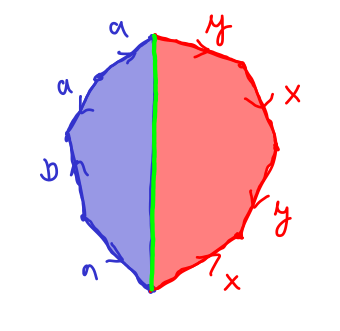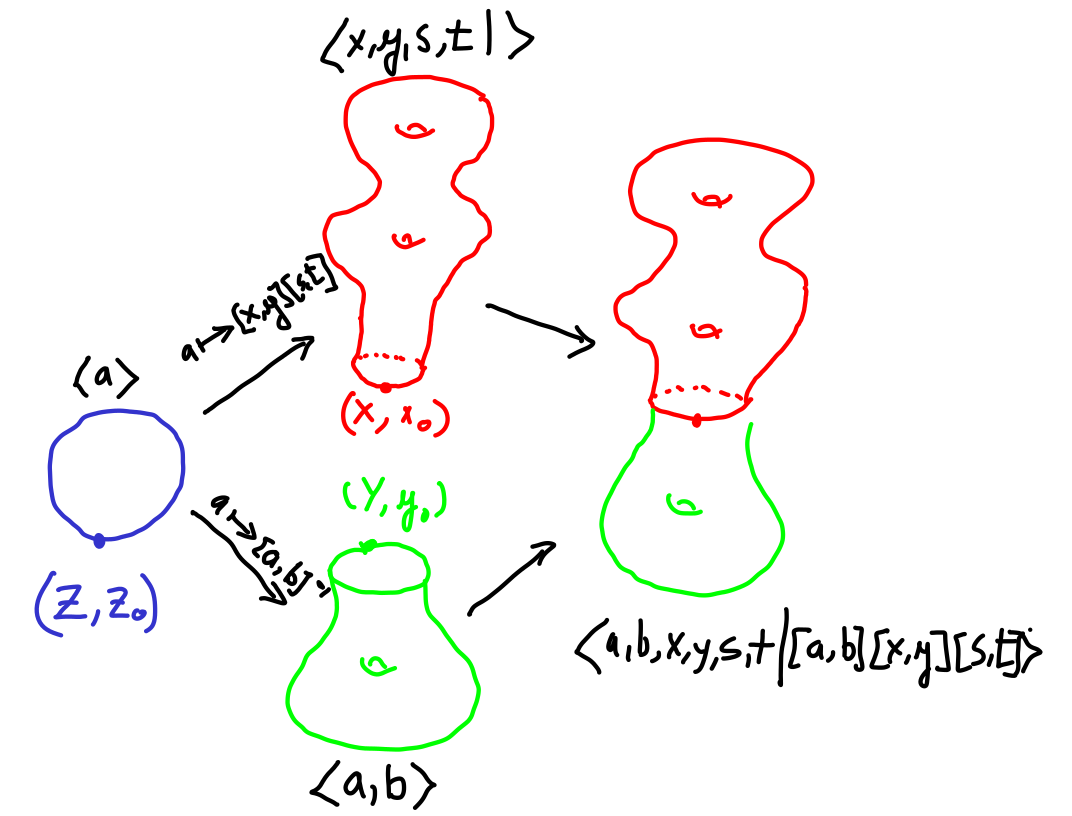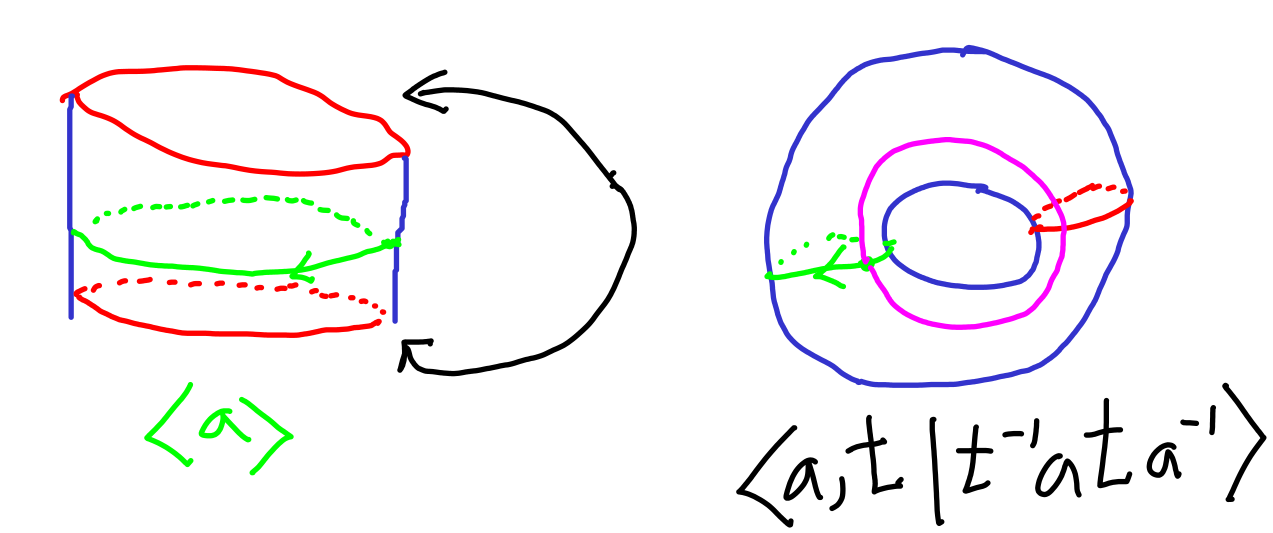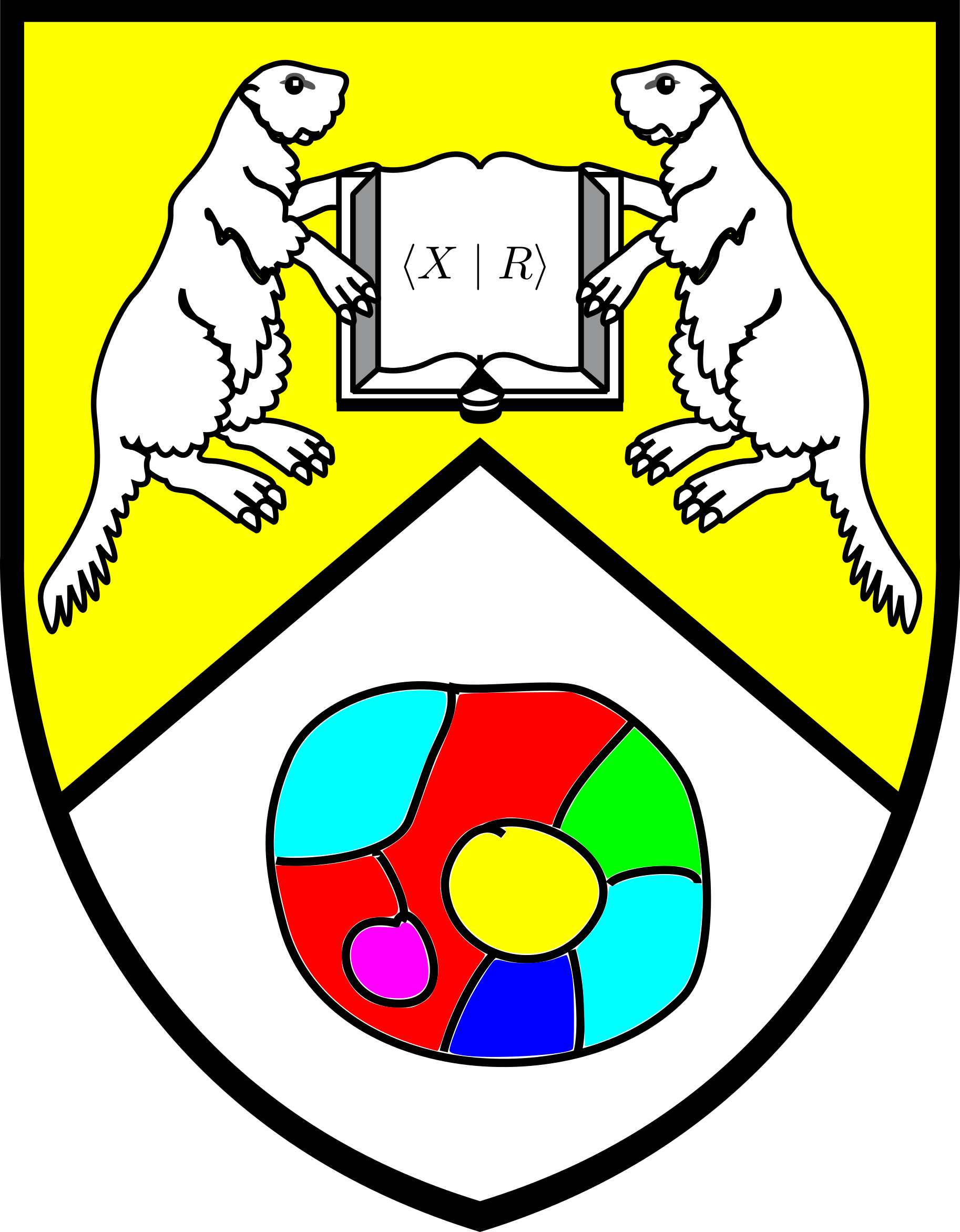Section 3.3 A pause: why are doing any of this anyway?
In the previous chapter we presented HNN extensions. The motivation for doing so was to demonstrate the effectiveness of van Kampen diagram arguments. That said why should anybody care about HNN extensions to begin with? In this section we will try to place HNN extensions into a larger (and more interesting) context.
One thing HNN extensions are good for are to construct groups with interesting properties, for example we constructed \(\mathrm{BS}(1,2)\) as an HNN extension of \(\ZZ\) and in so doing were able to show that some subgroups are not quasi-isometrically embedded.
Another important application is as follows. A state of a Turing machine (i.e. a theoretical computer) consists : one of finitely many an internal state \(\{Q_1,\ldots,Q_r\}\text{,}\) and the string of symbols written on a tape. It is possible, by a clever choice of normal forms, to encode the state of a as elements of some group \(H\) so that, given a state \(s\text{,}\) there is a corresponding a word \(w_s\) and corresponding group element. Crucially different states give different group elements. A transition \(s_1\to s_2\) is achieved by an HNN extension \(H*_t\) such that
From there, using elementary but clever arguments, it is possible to construct a group with undecidable word problem and to show that the isomorphism problem is undecidable. An interested reader can consult Chapter 9 of [6] for a thorough account.
Besides creating designer groups, HNN extensions play a much deeper role.
Subsection 3.3.1 The amalgamated product: the HNN extension's more popular sibling
Given groups \(G,H\) it is possible to form their Cartesian product \(G\times H = \{(g,h)\mid g\in G,h\in H\}\) with multiplication defined componentwise. Another way of combining groups is via a free product which we define in terms of presentations as follows:
- Let \(G = \pres X R\) and \(H = \pres Y S\text{,}\) then the free product is:
- \begin{equation*} G*H = \pres{X,Y}{R,S} \end{equation*}
Where we abuse notation and write, for example, \(X,Y\) instead of \(X \cup Y\text{.}\) As for HNN extensions, elements of \(G*H\) are represented as words
where the \(a_i,b_j\) are (possibly empty) words in \(X^{\pm 1},Y^{\pm 1}\text{,}\) respectively. Call them \(G\) and \(H\)-syllables if you want. Here there are no relations involving letters from both \(X\) and \(Y\text{,}\) so an van Kampen diagram argument similar to, but easier than, the one used to prove Theorem 3.2.6 shows that we can assume \(G,H \leq G*H\text{.}\)
Note that if we present \(\ZZ = \pres{a}{}\approx\pres{b}{}\) then we find that
Even better, consider the trivial group \(\{1\}=\pres c c\) (i.e. a group with one generator that is declared to be trivial.) The trivial group admits the identity automorphism, in this case, given by \(c \mapsto c\) so we can form the HNN extension of the trivial group
So in this way, starting with the trivial group, it is possible to construct all free groups just by using HNN extensions free products. In fact only HNN extensions are sufficient.
Suppose now we are given two group \(G = \pres X R,H = \pres Y S\) and suppose we have a pair of injective homomorphisms:
i.e. \(G\) and \(H\) contains isomorphic copies of \(A\) as subgroups. Then these isomorphisms prescribe a way of making a new group by "gluing" \(G\) and \(H\) along the images of \(A\text{.}\) The amalgamated product of \(G\) and \(H\) over \(A\) is the group
Note here that although \(A\) is not a subgroup of \(G\) or \(H\) we have for all \(a \in A, \psi(a)\in G, \varphi(a) \in H\) so that the set of amalgamating relations \(\{\psi(a)\varphi(a)^{-1} \mid a \in A\}\) can in fact be written as words in \((X\cup Y)^{\pm 1}\text{.}\)
Similarly to the case with HNN extensions, we can observe that ther only relations containing letters from both \(X\) and \(Y\) are the amalgamating relations, so in van Kampen diagrams we have amalgamating 2-cells. Similarly to the case for HNN-e-cells we can draw tracks in such 2-cells. 
Using the arguments of the previous chapter we can prove analogous results for amalgamated products, like embedding theorems, i.e. \(G \leq G*_A H\) and the analogue of Britton's lemma, i.e. if a word
Then either some syllable \(G \ni a_i \in \psi(A)\) or \(H \ni b_j \in \varphi(A)\text{.}\) Finally if the amalgamating subgroup \(A\) is finitely generated and both \(G\) and \(H\) are finitely presented, then the amalgamated product is finitely also presented (again same argument as for HNN extensions.) The only difference is that tracks are nicer to draw in the HNN case.
Ultimately the reason why amalgamated products are more popular is that gluing two groups together along a subgroup is more intuitively easier to understand than whatever is done for HNN extensions. Both are equally important.
Subsection 3.3.2 Stop avoiding the question! Why should I care?
It is now time to have the talk about category theory. So, um... when a mother and a father, or any couple whose members may or may not have biary genders, care alot for each other... oops wrong talk.
A category consists of a collection of objects and a collection of arrows between these objets, sometimes called morphisms. In practice categories consist of objects of the same type. Here are some examples:
- The category \(\mathbf{set}\) whose objects consists of all sets (so the collection of objects in a category need not be a set [ignore this parenthesis if you don't know about Russell's paradox]) and the morphisms are functions.
- The category \(\mathbf{group}\) whose objects are groups and whose morphisms are homomorphisms.
- The category \(\mathbf{AbGroup}\) whose objects are abelian groups and whose morphisms are homomorphisms.
- The category \(\mathbf{Zmod}\) whose objects are \(\ZZ\)-modules abelian groups and whose morphisms are \(\ZZ\)-linear homomorphisms.
- A based topological space consists of a pair \((X,x_0)\) where \(x_0\) is some point in \(X\) called a basepoint and we can form a category out of these objects by taking based continuous functions denoted\begin{equation*} (X,x_0) \to (Y,y_0) \end{equation*}are continuous map \(X\to Y\) that map basepoints to basepoints, i.e. \(x_0 \mapsto y_0\text{.}\)
- A directed graph forms a small category the objects are the vertices and arrows are the edges (which are literally arrows.)
We also have rings, field extensions, etc.
Certain categories have features that others don't. For example for all the listed categories, except the small category, each object admits an arrow to itself: the identity arrow, which acts as the identity function. Again, with the exception of the small category, all other morphisms come from functions so we have a composition operation
on morphisms, provided their domains and codomains match up.
One advantage of category theory is that we can universally define concepts. For example the categories of groups, abelian groups, \(\ZZ\)-modules, and rings are all algebraic we have for example the following:
- An isomorphism is a morhpism \(f:A \to B\) such that there exists another morphism \(g\) such that \(g\circ f = 1_A\text{,}\) the identity morphism on \(A\text{.}\)
- Up to unique isomorphism (i.e. there may be multiple objects that have this property, but for any two there is a unique isomorphism between them), the trivial object \(T\) is the object such that for any other object \(A\) there exists a unique surjective morphisms \(f:A \to T\text{.}\) I.e. the trivial object is the universal receiver.
- If we define the cokernel of a morphism to be it's image then we have the first isomorphism theorem\begin{equation*} \mathrm{coker}(f) \approx \mathrm{dom}(f)/\ker(f) \end{equation*}
Note that free groups play the opposite role as a universal sender.
Subsection 3.3.3 Come one! You just gave me yet another super abstract thing not to care about!
I assure you there is a point to this!
Certain constructions can also be defined categorically for example. Take two objects \(A,B\) we want to define a third object \(C\) which satisfies the following property: There is a pair of surjective morphisms (also called epimorphisms) \(p_A:C\to A, p_B:C\to B\) such that for any object \(T\) and any pair of morphisms \(\psi:T \to A\) and \(\phi:T \to B\text{,}\) there to exist a unique morphism \(\rho\) which makes the following diagram commute:
Note that if another object \(C'\) also satisfies this property, we can put in the place of \(T\) in the diagram and use the projection functions and we'll get that \(C' \approx C\) and that this isomorphism is unique.
In this way we have a completely categorical definition of a (direct) product. In category theory a cool thing to do is to put the word co in front of stuff and reverse arrows. Compare the diagram below with Figure 3.3.2.
In the category of groups the coproduct of \(A,B\) is the direct product \(A*B\) given at the very beginning of this section. Indeed for \(A*B\) we mentioned a van Kampen diagram argument which gives the inclusion \(i_A:A \into A*B\text{,}\) furthermore the maps \(\psi,\phi\) fully specify images of a generating set of \(A*B\) into \(T\text{,}\) finally by Lemma 1.6.1 it is immediate that all the relations on \(A*B\) vanish, thus giving us our unique homomorphism, compatible with the given \(\psi,\phi.\)
Thus, even though a direct product seems just like stupidly smashing two presentations together, in the category of groups, the free product realizes the coproduct, i.e. the dual of the direct product. Amalgamated products and HNN extensions can also be similarly be defined, albeit with more complicated diagrams. For example amalgamated products are the result of dualizing fibre products. Have another look at (3.3.1).
Incidentally, in the categories of \(\ZZ\) modules and rings, coproducts are direct sums, i.e. \(A\oplus B\) and products are \(A \times B\text{,}\) which unless when taking infinitely many terms, are interchangeable. In group theory coproducts are more complicated because of the non-commutativity.
Subsection 3.3.4 Okay, so maybe smashing presentations together isn't that random after all. What is it good for?
We must now discuss functoriality. A functor \(F\) is a map \(F:C_1 \to C_2\) between categories such that for any arrow \(A \stackrel{f}{\to} B\) in \(C_1\text{,}\) in \(C_2\) we have \(F(A) \stackrel{F(f)}{\to} F(B)\text{.}\) Let's give some examples.
- Every group has an underlying set, and every homomorphisms is a function. We therefore have the forgetful functor \(F:\mathbf{group} \to \mathbf{set}\text{.}\) We say it's forgetful because we forgot about the algebra.
- Every \(\ZZ\) module is an abelian group via the addition operation. Conversely any ableian group \(A\) admits a \(\ZZ\) multiplication via the exponentiation map \(g \mapsto g^n\text{.}\) Since \(A\) is abelian exponentiation is \(\ZZ\)-linear, i.e. \((gh)^n = g^n h^n\text{,}\) for all \(n \in \ZZ.\) Since \(\ZZ\)-linear homomorphism are group homomorphism, and abelian group homomorphisms commute with exponentiation (and therefore have a linear structure). We have functors \(F:\mathbf{AbGroup} \to \mathbf{Zmod}\) and \(G:\mathbf{Zmod} \to \mathbf{AbGroup}\) with \(F\circ G = Id\text{,}\) so the categories of ablian groups and \(\ZZ\)-modules are isomorphic. Functionality thus gives a rigorous way of saying abelian groups and \(\ZZ\) modules are the same thing.
- In Section 1.8 we mentionned abelianization: take any group \(G\) and add relations so that all its generators commute. This gives an ableian quotient group \(G_{ab}\text{.}\) Again Lemma 1.6.1 tells us that given a morphism \(f:G\to H\text{,}\) following the images of generators gives another morphism \(f_{ab}:G_{ab} \to H_{ab}\text{,}\) so abelianizaition is a functor. Moreover since abelian groups are isomorphic to \(\ZZ\)-modules. We can use ableianization and linear algebra as a tool to study groups. Recall that this was sufficient to prove that free groups of different rank are not isomorphic, and can be used to show that if a group has fewer relations then generators, then it is non-trivial and in fact infinite.
The importance of amalgamated free products and HNN extensions shows up in topology. Let \((S^1,s_0)\) be a based circle and let \((X,x_0)\) be a based space. Then a contiuous based map \(\gamma: (S^1,s_0),(X,x_0)\) is a loop in \(X\) based at \(x_0\text{.}\) The set of based loops of \((X,x_0)\) (modulo homotopy), with the concatenation opeation form the fundamental group of \((X,x_0)\) denoted
Remarkably, although we have a continuum of based loops, if we only consider homotopy classes, then in many cases we have a countable set, in fact: A group \(G\) is finitely presented if and only if it acts properly and cocompactly by isometries on a simply-connected geodesic space
Theorem 3.3.4.
Basically the fundamental group of any compact manifold or CW complex will be finitely presented. It is in this context that the study of groups with generators and relations originated.
Now if \(\gamma :(S^1,s_0) \to (X,x_0)\) is a loop and \(f:(X,x_0) \to (Y,y_0)\) is a continuous map, then \(f\circ\gamma\) is a loop in \((Y,y_0)\text{.}\) In a topology course it is shown that the map:
where \([\gamma]\) represents a based homotopy class in fact is a homomorphism
Thus \(\pi_1\) gives a functor from the category of based topological spaces to the category of groups.
Consider not the following generalization of a coproduct. Supose we have a pair of injective morphisms \(i_X:Z\into X,i_Y:Z \into Y\) then the coproduct over \((i_X,i_Y)\) is an object \(C\) equipped with two inclusions \(\rho_X:X \into C,\rho_Y: Y\into C\)such that givem any triple of commuting maps \(\phi_X,\phi_Y\) from \(X,Y\) (respectively) to any object \(T\text{,}\) there exists a unique a unique map \(f:C \to T\) making the following diagram commute:
Note that our diagram commutation requirement means that we have an equality of compositions
If the standard coproduct was the free product, it should not come as a surprise to the reader that the the coproduct ovar a pair of monomorphisms is nothing else than the amalgamated product.
We therefore have two definitions of the amalgamated product: a concrete one involving an explicit presentation and one using the language of category theory, also affectionately known as abstract nonsense.
What good is abstract nonsense? Let us now turn our attention to based spaces. Let us first define an injective continuous map \(f:(Z,u_0) \into (X,x_0)\) to be \(\pi_1\)-injective if it's functorial image \(f_\sharp \pi_1(U,u_0) \to \pi_1(X,x_0)\) is also injective. And consider the diagram Figure 3.3.5 in the context of of based spaces. Then the universal object in the category of based spaces is the topological space \(X\cup_Z Y\) obtained by gluing \(X\) to \(Y\) as prescribed by the pair of functions of from \(Z\) to \(X,Y\text{.}\)
As an immediate consequence of functoriality, we get the Seifert van Kampen (yes the same van Kampen) theorem: the fundamental group of space obtained by gluing spaces together is obtained by gluing the fundamental group together.

Actually, the real Seifert van Kampen theorem handles when the inclusion maps are not \(\pi_1\)-injective, but is proved the same way (it's just that we would have to generalize amalgamated products and all that stuff, but there is nothing new needed.)
The mysterious HNN extensions occurs when a space gets glued to itself, basepoint issues make things awkward, however.

Subsection 3.3.5 Final remark.
In the field of combinatorial and geometric group theory, we typically require that the amalgamating subgroup is mapped injectively. We could relax the definition of an amalgamated product and no longer require the maps \(i_X,i_Y\) to be injective as below:
For example: the unit disc \(D\) has \(\pi_1(D)=\{1\}\) whereas the unit circle \(S^1\) has \(\pi_1(S_1)=\ZZ\) we certainly have the inclusion \(S^1 \subset D\text{,}\) and this inclusion is not \(\pi_1\)-injective. The full Seifert van Kampen Theorem covers this case.
This Seifert van Kampen Theorem is the one of the main tool used to study the fundamental groups of topological spaces, a field in which one of the most important results of this century has been made:
Theorem 3.3.9. Poincaré conjecture.
Let \(M\) be a closed 3-manifold. Then \(M\) is homeomorphic to the the 3-sphere \(S^3\) if an only if \(\pi_1(M)=\{1\}\text{.}\)
